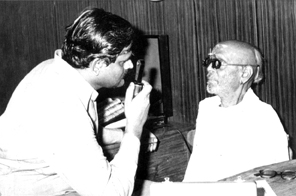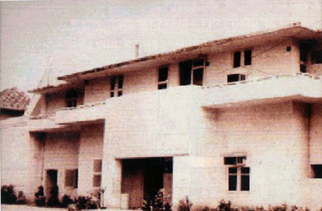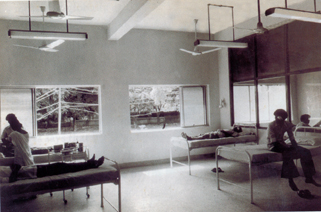|
If there is one man who is identified with Chennai's super-speciality eye hospital Sankara Nethralaya, it is Dr. Sengamedu Srinivasa Badrinath. But, as he himself would have it, "Its story is the story of my colleagues who stood by me, the story of millions of patients who reposed trust in us, and a benevolent society that supported us."

Dr. Badrinath examining an elderly patient in the early days of the hospital.
|
That story is told in In-Sight, the chronicle of Sankara (Good-doer) Nethralaya (Temple of the Eye). The tag line 'Sankara Nethralaya's Passion for Compassion' lets you into what's in store.
Badrinath's tryst with his calling came at age four when he observed the plight of a relative blind in both eyes. This experience seems to have stayed with him, and the decision to become an eye specialist was made when he stood first in Ophthalmology in his MBBS university exams while passing out of Madras Medical College. For his postgraduate studies, he flew to the US and interned at Grasslands Hospital near New York. Then came a six-month study of basic sciences in ophthalmology in Manhattan's New York University Post Graduate Medical School. Later, Dr. Badrinath worked with retinal surgeon Dr. Fred Gottlieb at the Brooklyn Eye and Ear Infirmary. Here he honed his skills in detachment surgery, a procedure which restores sight to a blind person. His mentor encouraged him to move to Boston to work with Dr. Charles L. Schepens, who was considered the 'father of modern retinal surgery'. After a year and a half with Dr. Schepens at the Massachusetts Eye and Ear Infirmary, and, soon after passing his FRCS (Canada) and diplomate of the American Board of Ophthalmology in 1970, he returned to Madras. In mid-1970 Dr. Badrinath started his practice at the Voluntary Health Services (VHS), Taramani. He was paid Rs.250, a token amount to cover his travel expenses. But the hospital imported with German funds a xenon-arc photo-coagulator on Dr. Badrinath's recommendation to treat patients with diabetic retinopathy, a major cause of blindness in India. Patients from all over the country thronged the VHS to consult Dr. Badrinath.
Towards the end of 1970, Dr. Badrinath started evening practice at the H.M. (Hirendra Mehta) Hospital in Abhiramapuram. Here he met Dr. P.C. Reddy, who was to found Apollo Hospitals, but who had at the time joined H.M. after returning from the US. Their friendship continues to this day. After three years at H.M. Hospital, Dr. Badrinath moved to Vijaya Hospital, Vadapalani, but continued as a consultant to VHS and H.M. Hospital. During those early years, Dr. Badrinath treated former Finance Minister TTK and the doyenne of Carnatic music MS, among other VIPs.
1974 was a landmark year in Dr. Badrinath's career. He was called upon to treat his spiritual guru, Sri Chandrasekharendra Saraswathi Swamigal. One of the Guru's eyes, previously treated for cataract, had got infected and the Swamigal had lost vision in that eye. Now, the other eye too required cataract surgery. Dr. Badrinath and his wife would wake up daily at 3 a.m. for two months and go to Kancheepuram to nurse their guru. And the guru reciprocated by not wetting his hair for some days after the surgery in deference to the surgeon's wishes because, he said, ''He is a doctor. If I develop complications, it will only spoil his name and standing as an eye surgeon.''
The next year, Sri Jayendra Saraswathi addressed a group of 50 influential doctors in Madras, exhorting them to treat India's poor patients with the best medicare and with missionary zeal. This was instrumental in Dr. Badrinath starting Sankara Nethralaya under the auspices of the Medical Research Foundation (MRF) in September 1978 with the help of a group of philanthropists. Among them were industrialist and star fund-raiser V.D. Swamy, leather merchant C.U. Shah, who donated Rs.10 lakh, and the Maneckjis' who sold two acres of land with a bungalow in the heart of the city in Nungambakkam for a price brought down by Rs.6 lakh from the Rs.14 lakh it was being offered in the market. There was all-round support for the hospital, including from the Agarwal Eye Institute. In fact, Dr. (Mrs) T. Agarwal cut the ribbon to inaugurate it. In 1998, the legal luminary, Nani A. Palkhiwala, donated Rs.12 crore to help Sankara Nethralaya take over the Lady Willingdon Hospital in the same neighbourhood, so that it could expand. Then Ratan Tata donated Rs.5.5 crore.
When the hospital was started, Dr. Badrinath did not qualify to be on top of the list of employees, but the honour went to his driver, A. Arumugam. Dr. S. Bhaskaran, who calls himself an 'early bird' in the institution joined in 1979-80. Dr. Badrinath was keen, when it was not the norm 35 years ago, to put his patients coming to him for eye surgery through a thorough physical examination, and so he enlisted the services of Dr. Bhaskaran, a cardiologist, who is today the Director, Internal Medicine, and Chairman of the Foundation.
Among the other doctors who were absorbed fresh out of college and still continue there is Dr. Prema Padmanabhan, who heads the Corneal and Refractive Surgery Department. Then came Dr. Lingam Gopal and Dr. L. Vijaya, a couple, who have spent more than two decades at Nethralaya, and Dr. Jyotirmay Biswas who has been in Nethralaya for 26 years. The authors point out that since the personal and professional lives of the doctors were often intertwined, 19 couples have been on the rolls of the institution in its journey of 30 years. Of course, the credit of being the 'First Couple' of Sankara Nethralaya goes to Dr. Badrinath and Dr. Vasanthi Badrinath. All the other couples have both been doctors with the exception of Dr. T.S. Surendran and Jayanti Surendran, a senior administrator.
Dr. Tarun Sharma, who has been with the institution for more than 25 years, sees an invisible divide in Nethralaya's work ethic – the pre-incentive and post-incentive eras. ''The change unfortunately goes against the grain of Sankara Nethralaya's philosophy that work is worship,'' he adds.
In-Sight has been authored by V.V. Ranganathan, George Skaria and Meera Prasad. Former President A.P.J. Abdul Kalam has written the Foreword, and Dr. Badrinath has a message in it. The book itself is dedicated to 'All those who bring in a sense of belonging to our country.'
The book offers personal details of the rise into eminence of Dr. Badrinath and his colleagues, the teamwork in front of and behind the scenes, and anecdotes about well-known and unknown patients.
One anecdote is about Chief Minister MGR in 1980 asking Dr. T.S. Surendran of Sankara Nethralaya to prescribe one lens for distance vision for one eye and another lens for near vision for the other eye. When told that it may cause trouble, MGR asked him, ''Trouble for you or for me?'' Dr. TSS said, ''Trouble for you, Sir, because it can confuse you and it will be difficult for you.'' On MGR's insistence, Dr TSS reluctantly prescribed the lenses. Later, while attending a conference in Chicago, the doctor discovered Monovision, an optical means of correction of presbyopia, where one eye is corrected for distance vision and the other eye is corrected for near vision using different lenses. So much for MGR's insights into medicine and health.
In accordance with the mantra of the super-speciality eye hospital, for the society by the society, several opinion leaders have offered their take on the larger role of social enterprises. Gopalkrishna Gandhi, A.M. Naik, Dr. Vasanthi Badrinath, N. Murali, Mallika Srinivasan, Rahul Bajaj, Rakesh Bharti Mittal, Dr. Prathap C. Reddy and Deepak S. Parekh have put down their perspectives on the role of not-for-profit organisations in the context of the successful track record of Sankara Nethralaya. The chronicle also comprises stand-alone shaded pages of interesting information like 'Key milestones' of Sankara Nethralaya, 'Eyes are disease detectors' followed by what makes the 'Human eye work', 'Bionic Eyes,' 'Visual acuity demystified,' and 'Gandhiji's spectacles'.
This particular social enterprise has, from its humble beginnings as a 17-bed hospital, one ophthalmologist and six employees, grown into 12 centres across the country, 1400 employees, 82 ophthalmic consultants, more than 100 research students, more than 1000 alumni and treats 450,000 patients a year.
Nearly 50 per cent of its outpatient services and almost 43 per cent of its surgeries are totally free. All this and more is detailed in In-Sight brought out by Lone Tree without any recompense. It is a moving book about dedicated service to people.

The Maneckjis' bungalow in College Road where Nethralaya commenced operations.
|

A ward in the 17-bed hospital that was the start.
|
|